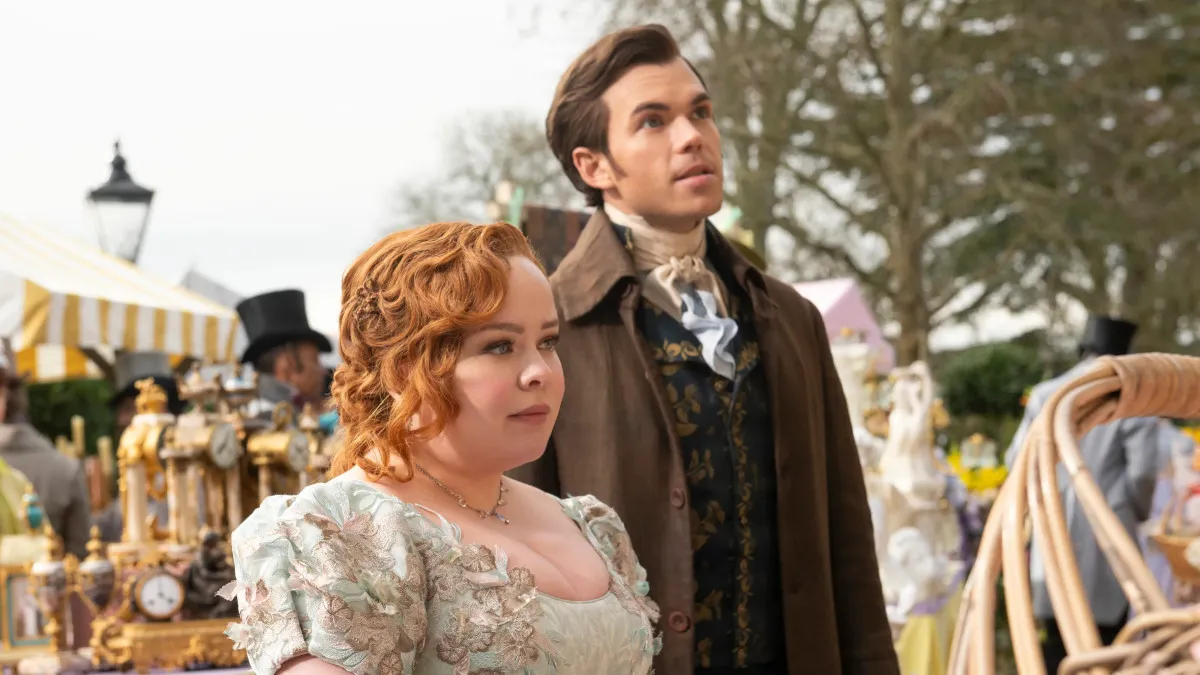
Bridgerton season 3 is finally almost here. Colin (Luke Newton) will be helping Penelope (Nicola Coughlan) find a husband—though I don’t think that’s going to play out the way he expects—while the other members of the Bridgerton family and the rest of the Ton navigate the grueling London social season once again.
Get ready for more steamy romance, longing gazes, and dramatic tension, all heightened by the era in which the show takes place. Nothing is more tantalizing and intriguing than teasing touches and stolen glances, after all, and with the eagle-eyed members of the Ton watching their every move, Penelope and Colin will be forced to explore their romance behind closed doors.
But how accurate is the Ton’s scrutiny, anyway? Is Bridgerton based on a true story, or are Julia Quinn’s novels entirely fictional?
How much of Bridgerton is based on real history?
Basically, it’s a mix between the two. While the show (and the books) feature a few genuine historical figures and mostly follow the traditions and social norms of Regency-era London, the show has taken quite a few steps to ensure that its version of high society is more diverse and feminist than would have generally been allowed or expected during that time.
The show is highly stylized as well—the costumes aren’t always 100% historically accurate, and the music is, well, clearly mostly pop music (though it’s always fun to figure out which song is being covered by a string quartet during a particular scene), but that doesn’t mean that nothing in the story isn’t based on real history.
For instance, the Bridgerton family as seen in the show is entirely fictional, but Queen Charlotte and King George III certainly were real people—though it’s still debated whether the actual Queen Charlotte was Britain’s first Black Queen or not, as it’s technically possible she had African ancestry. They did, by all accounts, have an unusually happy marriage in those first few years, as portrayed in Queen Charlotte: A Bridgerton Story, Netflix’s prequel miniseries, and they did have a large number of children, too, as seen in the show. King George’s health issues and his declining mental acuity are also based on historical reports, and the strain this put on their relationship is likely accurate as well.
Whether the real Queen Charlotte meddled in the Ton’s affairs as much as she does in the show is unclear, though probably inaccurate. During the era in which Bridgerton takes place (early 19th century England), it was actually their son who ruled in George’s stead. Still, the Queen’s search for Lady Whistledown and her interest in the relationships of high society is one of the most fun parts of the show, and Golda Rosheuvel’s performance is incredibly entertaining, so we’ll let that slide—and the show does accurately portray how important it was to have the royal seal of approval in London’s high society at the time.
Additionally, the concept of “the Ton” is historically accurate as well. As explained by History Extra, Ton comes from the French phrase “le bon ton,” which essentially means “good manners” and “good taste.” After all, members of the Ton were society’s tastemakers, seen as fashionable, impeccably polite, and well-behaved. Many of the traditions and rules seen in Bridgerton are accurate, too, including the idea of dance cards, daughters coming out to society, the need for chaperones, socializing during a promenade (which did genuinely happen on Rotten Row in Hyde Park), and more.
Even Lady Whistledown’s scandal sheet is rooted in real history, though, at the time, as History Extra notes, the names of the people involved would have likely been omitted from the writing, though not necessarily as a means of disguising who it was about. It was mostly just about avoiding libel laws, something the show hasn’t really touched on (but might in season 3, with Penelope being the focus). Scandals that broke in these magazines and columns could genuinely make or break a family, though perhaps the stakes weren’t always as high as they are in Bridgerton.
While the concept of a season’s “diamond of the first water” doesn’t seem to be real, either, some young women were praised for their beauty in certain papers and magazines, garnering them more attention and better prospects than others—simply put, those women became local celebrities. Will it be Francesca Bridgerton’s turn this time around?
At least we know there’s plenty more scandal, gorgeous costumes, and swoon-worthy romance to look forward to in Bridgerton season 3, whether it’s historically accurate or not. As Queen Charlotte: A Bridgerton Story so accurately claims, Netflix’s Bridgerton world is “… not a history lesson. It is fiction inspired by fact.”
The first four episodes of Bridgerton season 3 drop on Netflix on May 16. The second half of the season will be available on June 13.





